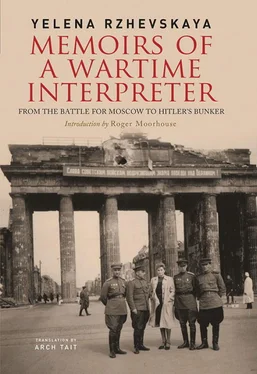This was a German starkly confronted with the death of Hitler, but Echtmann himself had been through too much, having lived with his wife and daughter in Berlin throughout the war, to be shocked by anything. He inspected Hitler’s teeth calmly. When, however, he looked at Eva Braun’s, he became agitated. On 11 May he said, and I wrote it down,
This way of constructing a dental bridge is my own invention. I did not make such a bridge for anyone else, and have never seen a similar way of attaching the teeth devised by anybody else. It was in the autumn of 1944. Braun rejected my first bridge because, when she opened her mouth, the gold was visible. I made a second bridge, eliminating that snag. I used a very original technique.
Many years later I saw a photograph of Fritz Echtmann in the December 1964 issue of the West German Stern. He had two fingers raised and had been photographed as he testified under oath to a court in Berchtesgaden that he really had identified Hitler’s teeth on 11 May 1945, and could thus certify that he was dead.
The Missing Link
Back in 1945 we were, unfortunately, not aware of the testimony of two other very important witnesses of Hitler’s death: Otto Günsche and Hans Rattenhuber. They were both taken prisoner in sectors allocated to our neighbouring army, but there was no staff headquarters or any centre coordinating our separate activities. Later, their testimonies ended up in the same place in the archive as our documents, but it was almost twenty years before I was able to read them. How desperately we needed, from the very outset, people who had witnessed Hitler’s death, his cremation and burial.
Our investigation was already nearing its end when the Smersh agents of Lieutenant Colonel Klimenko detained a member of Hitler’s SS bodyguard, Harry Mengershausen. A handsome, broad-shouldered fellow, now wearing civilian clothes, Mengershausen said he could indicate the place where the bodies were hidden, covered with earth and rubble. He pointed out the crater, not knowing that the bodies had already been removed from it.
Klimenko had displayed a lack of conscientiousness, and even gloried in his negligent attitude towards the bodies of Hitler and Eva Braun. ‘Frankly,’ he wrote to me, ‘ I wasn’t that bothered, and in any case I had more urgent things to do than mess about with these corpses, especially since I’m squeamish, so I went out of my way to avoid them.’ That was the reason he sent Deryabin, instead of going personally, to retrieve the bodies from the crater. Now, however, he moved with commendable alacrity. Lieutenant Colonel Klimenko, with a group of officers and men, returned with Mengershausen to the Reich Chancellery and an official report was compiled:
1945, the thirteenth day of May, Berlin
We, the undersigned… with the participation of identification witness Mengershausen, Harry, have this day inspected the burial site of the bodies of Reich Chancellor Adolf Hitler and his wife…
Inspection of the location indicated by identification witness Mengershausen established the truthfulness of his testimony… The testimony of identification witness Mengershausen was confirmed as true all the more because on 4 May 1945 we had removed from the crater he indicated the burnt bodies of a man and a woman and two poisoned dogs, which were identified by other identification witnesses as those of Hitler and his wife, Ifa [sic] Braun, his former personal secretary.
A rough survey of the location where the bodies of Hitler and his wife were discovered and photographic images of the locations indicated by identification witness Mengershausen are appended to this report.
As witness this report compiled in the city of Berlin, Reich Chancellery.
The document was signed by Lieutenant Colonel Klimenko, Senior Lieutenant Katyshev, Guards Major Gabelok, photojournalist Junior Lieutenant Kalashnikov, and Privates Oleynik, Churakov, Navash and Myalkin.
A copy of this document was mailed to me by Ivan Klimenko when he heard my book was being prepared for publication. He also wrote,
I brought this report containing Mengershausen’s testimony to the army counterintelligence department, which is where I saw you.
This concluded the work of the Smersh department of the corps. Everything else was undertaken by the army and front headquarters.
Major Bystrov interrogated Mengershausen and I translated. We were sitting on logs in the courtyard. Mengershausen told us,
On 30 April I was guarding the Reich Chancellery, patrolling the corridor where the kitchen and green dining room are situated. Additionally, I was monitoring the garden because at a distance of 80 metres from the green dining room was the Führer’s bomb shelter.
Patrolling the corridor and approaching the kitchen, I met someone I knew to be the Führer’s orderly, Bauer, who was going to the kitchen. He told me that Hitler had shot himself in his bunker. I enquired as to the whereabouts of the Führer’s wife, and Bauer told me she too was lying dead in the bunker, but he did not know whether she had poisoned or shot herself.
I talked to Bauer for only a few minutes: he was hurrying to the kitchen. In the kitchen food was being cooked for Hitler’s entourage. He returned shortly afterwards to the bunker.
I did not believe Bauer’s report of the death of Hitler and his wife and continued to patrol my area.
Not more than one hour after meeting Bauer, as I came out to a terrace situated 60–80 metres from the bunker, I suddenly saw the personal adjutant, Sturmbannführer Günsche, and Hitler’s valet, Sturmbannführer Linge, carrying the body of Hitler from the emergency exit of the bunker and placing it 2 metres from the exit. They went back and a few minutes later brought out Eva Braun, who was dead, and whom they put in the same place. Some way from the bodies there were two twenty-kilogram cans of petrol, Günsche and Linge began to pour petrol over the bodies and set fire to them.
Major Bystrov enquired whether any of the other guards had seen the bodies of Hitler and Braun being burned. Mengershausen did not know for sure. ‘Of all the security guards I was the closest to Hitler’s bunker at that time.’ He bent down and began to outline a map of the garden on the ground with a piece of wood.
Thus we found our missing link: somebody involved in or who had witnessed the actual cremation, who would have been so helpful in the first phase of our mission, when we were hunting Hitler. We went into the house with Mengershausen and wrote down everything he had told us.
From his post Mengershausen had been able to see only Günsche and Linge but, shielded by the bunker, hiding from the shellfire, Goebbels, Bormann and the others were observing the burning of the bodies. Nearby, a battle was raging; the Reich Chancellery was under intense bombardment. The wailing of shells, the crash of explosions throwing up columns of soil, the smashing and whistling of flying window glass. The buffeting wind disturbed the clothing on the bodies. The fire flared up and then died down as the petrol burned off. More petrol was poured over them and again ignited.
Then what did Mengershausen do? He escaped, acting on his own initiative and without waiting for new orders. ‘That same day, 30 April, I changed into civilian clothing and hid in a cellar.’ He was wearing a raincoat that was too short for him and obviously belonged to somebody else. His long arms protruded from the sleeves. Major Bystrov handed him a photograph of the Reich Chancellery garden. I translated, ‘Tell me what you see in this photo.’
This is a photo of the emergency exit from Hitler’s bomb shelter. I know this place well and can show you where the bodies of Hitler and his wife Braun were burned, and also the place where they were buried.
Читать дальше











